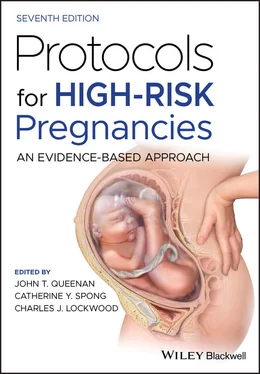Detailed anatomical survey at 18–20 weeks.
Serial growth ultrasounds every month; add fetal surveillance if fetal growth restriction develops.
Consider daily aspirin for preeclampsia prevention.
Maternal BP monitoring.
Lab evaluation if concern for crisis (increased pain) including CBC, reticulocyte count, lactate dehydrogenase, haptoglobin, urinalysis, urine culture.
Discuss maternal immunization as SCD causes patients to be functionally asplenic. Patients with SCD should receive the following (in conjunction with SCD provider). All below immunizations are safe in pregnancy.Haemophilus influenzae type B (Hib) vaccine: one dose during their lifetime.Meningococcal vaccine: two‐dose series at least eight weeks apart initially and revaccination every five years.Pneumococcal vaccine: one dose of PCV13 followed by one dose PPSV23 at least eight weeks later. Repeat PPSV23 five years after initial PPSV23.Yearly influenza vaccine.
Folic acid supplementation (4 mg/day).
Antepartum management (acute pain crisis)
Maternal vital signs.
Supplemental oxygen to maintain saturations >95%.
Aggressive fluid resuscitation.
Initial laboratory testing: type and screen, CBC, reticulocyte count, LDH, haptoglobin, urinalysis, urine culture.
Investigation of precipitating cause (infection, dehydration, severe anemia, etc.).
If oxygen desaturations or chest pain are present, then obtain chest x‐ray to evaluate for acute chest syndrome.
Provide adequate analgesia; opiates are often mainstay of therapy and continuous infusion/patient‐controlled anesthesia may be necessary.
VTE prophylaxis while in crisis.
Fetal assessment with fetal heart tones if previable or nonstress test if viable.
Antenatal steroids for evidence in the setting of nonreassuring fetal testing.
Empiric antibiotics if infection or acute chest syndrome is suspected.
Multidisciplinary care approach with hematology consultation.
Admission labs including type and screen and CBC. Consider early cross‐match if antibodies are present as obtaining compatible blood can be challenging for these patients.
Adequate analgesia, epidural anesthesia encouraged.
Adequate fluid hydration.
Maintain oxygen saturations >95%.
Mode of delivery according to normal maternal/fetal indications.
Alert pediatric team if neonate is at risk for hemoglobinopathy.
Continue to ensure adequate analgesia and hydration.
Maintain oxygen saturations >95%.
Contraception counseling including consideration of immediate postpartum long‐acting reversible contraception (LARC). All forms of contraception are safe in SCD (category 1 or 2 according to CDC Medical Eligibility Criteria).
Avoid hydroxyurea if breastfeeding. If not breastfeeding, can consider restarting hydroxyurea in consultation with SCD provider/hematologist.
Pregnancy management of thalassemias
Management of thalassemias in pregnancy does not differ significantly from management of low‐risk pregnancies. Patients who are affected or are carriers of either alpha‐thalassemia or beta‐thalassemia should be referred for genetic counseling and partner testing to assess risk for an affected fetus. Should they be at risk of an affected fetus, diagnostic prenatal testing should be discussed and offered in conjunction with a maternal‐fetal medicine consultation.
Patients with alpha‐thalassemia trait and HbH overall have favorable pregnancy outcomes affected by mild to moderate anemia and their care should not differ significantly from routine prenatal care. Patients with beta‐thalassemia minor will often have only a mild asymptomatic anemia. There have been reports of higher rates of fetal growth restriction with beta‐thalassemia minor and therefore a third‐trimester growth ultrasound should be considered. In all patients with any form of thalassemia, regular monitoring for anemia should be performed. Iron supplementation should not exceed normal prophylactic doses of iron unless laboratory evidence of iron deficiency is noted.
Pregnancies in women with beta‐thalassemia major were rare prior to the introduction of hypertransfusion and iron chelation therapy. Reports since that time have shown overall favorable outcomes. Per the American College of Obstetricians and Gynecologists, pregnancy in women with beta‐thalassemia is only recommended for those with normal cardiac function and who have undergone prolonged hypertransfusion therapy with iron chelation. These patients are at risk of fetal growth restriction and should be monitored with serial growth ultrasounds. During pregnancy, the goal for these patients is to maintain hemoglobin levels around 10 g/dL with serial transfusions as necessary. Iron chelation therapy is typically deferred during pregnancy given the paucity of data on its safety in pregnancy.
1 American College of Obstetricians and Gynecologists. ACOG Practice Bulletin No. 78: hemoglobinopathies in pregnancy. Obstet Gynecol 2007; 109(1):229–37.
2 Boafor TK, Olayemi E, Galadanci N, et al. Pregnancy outcomes in women with sickle‐cell disease in low and high income countries: a systematic review and meta‐analysis. Br J Obstet Gynaecol 2016; 123(5):691–8.
3 Brown JA, Sinkey RG, Steffensen TS, Louis‐Jacques AF, Louis JM. Neonatal abstinence syndrome among infants born to mothers with sickle cell hemoglobinopathies. Am J Perinatol 2020; 37:326–32.
4 Curtis KM, Tepper NK, Jatlaoui TC, et al. U.S. medical eligibility criteria for contraceptive use, 2016. MMWR Recommend Rep 2016; 65(3):1–103.
5 Howard J, Oteng‐Ntim E. The obstetric management of sickle cell disease. Best Pract Res Clin Obstet Gynaecol 2012; 26(1):25–36.
6 Kim DK, Hunter P. Advisory Committee on Immunization Practices recommended immunization schedule for adults aged 19 years or older – United States, 2019. MMWR 2019; 68(5):115–18.
7 National Institutes of Health. Evidence‐Based Management of Sickle Cell Disease, Expert Panel Report 2014. www.nhlbi.nih.gov/health‐topics/evidence‐based‐management‐sickle‐cell‐disease
8 Okusanya BO, Oladapo OT. Prophylactic versus selective blood transfusion for sickle cell disease in pregnancy. Cochrane Database Syst Rev 2016; 12:CD010378.
9 Oteng‐Ntim E, Meeks D, Seed PT, et al. Adverse maternal and perinatal outcomes in pregnant women with sickle cell disease: systematic review and meta‐analysis. Blood 2015; 125(21):3316–25.
10 Ware RE, de Montalembert M, Tshilolo L, Abboud MR. Sickle cell disease. Lancet 2017; 390(10091):311–23.
PROTOCOL 13 Fetal and Neonatal Alloimmune Thrombocytopenia
Russell Miller and Richard Berkowitz
Department of Obstetrics and Gynecology, Columbia University Medical Center, New York, USA
Fetal and neonatal alloimmune thrombocytopenia (FNAIT) is a maternal alloimmune condition in which specific maternal antibodies target paternally derived human platelet antigen (HPA) expressed on fetal platelets, resulting in potentially severe fetal and neonatal thrombocytopenia. Disease incidence has been estimated as 1 out of every 1000 live births, varying by ethnicity.
Fetal and neonatal alloimmune thrombocytopenia requires that a phenotypic incompatibility exists between the biological mother and father for a disease‐causing HPA antigen, and that the fetus inherits a paternally derived antigen that the mother does not possess, resulting in sensitization. The most common antigen implicated in disease is the HPA‐1a antigen, which is responsible for about 80% of confirmed cases. Common antigens implicated in FNAIT pathogenesis include HPA 1, 2, 3, 5, and 15 systems, and these together are believed to account for over 95% of cases.
Читать дальше












